
Typical street scene in Santa Ana, El Salvador. (Photo: iStock)
IMF Survey: Asia Ten Years After
May 30, 2007
- Crisis proved to be a temporary setback
- Combination of adjustment and reform helped turn the tide
- Most determined reformers first to claw back lost ground
Ten years ago, the Asian financial crisis of 1997-98 began to unfold.

Traffic in Bangkok, Thailand, where the Asian financial crisis began 10 years ago (photo:Saeed Khan/AFP)
Asian financial crisis
Few countries in the region were left untouched, and the aftereffects reverberated across the globe. A decade later, Asia shines in the global economic landscape, and its vitality stands out as a remarkable achievement. But what lies behind this success, and what are the new challenges for a region that has become a dynamo for the world economy?
A look back
In retrospect, the Asian financial crisis proved to be a temporary setback, despite its enormous economic and social costs. Its hallmark was the sudden reversal of investor sentiment and abrupt withdrawal of international capital. Doubts about the soundness of financial institutions and corporates spread quickly across national borders, creating a vicious circle of capital outflows, plummeting exchange rates, and crippling balance-sheet effects in the crisis-struck countries. Private demand collapsed and output in the most affected economies contracted quickly and sharply. The underdevelopment of social safety nets to protect those most exposed to economic disruptions exacerbated the social and economic impact of the slumps.
The international community stepped in to help as private investors were stampeding for the exits, providing external financing (including IMF assistance), while governments in the region adjusted policies, taking increasingly strong and appropriate action, and steps were taken to coordinate private sector financing. After some adjustments, this combination eventually turned the tide: confidence recovered and capital started returning. As financial and real sector weaknesses were tackled, output in the hardest-hit countries began expanding again. The most determined reformers were the first to claw back the ground lost and, by 2003, GDP in all crisis countries had surpassed its precrisis level (see Chart 1) GDP per capita took a bit longer to do so.
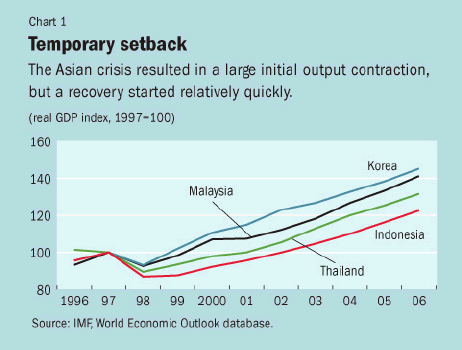
Fast-forward
Today, Asia is among the star performers in the global economy. The region found strength in no small part by turning crisis into opportunity. The testing times of the late 1990s have rekindled a sense of regional identity and shared economic destiny. Regional policy forums have taken on renewed importance. Policy cooperation is gaining traction, and initiatives like the Chiang Mai network of bilateral swap lines among Asian central banks, which is now being converted into a reserve pooling arrangement, or the Asian Bond Fund project provide a -welcome measure of self-insurance and commonality of purpose. In addition, intra-regional trade has grown rapidly, with the development of complex supply chains centered on China.
At the same time, Asia has not turned its back to the outward-looking orientation that propelled its spectacular rise on the world's economic stage. Intraregional commerce is so far complementing—not substituting for—global trade. With deepening financial and trade connections inside and outside the region, Asia's economic vitality 10 years after the crisis stands out. The countries that were most affected by the crisis have made good progress in laying solid foundations for continued growth and their medium-term prospects are bright.
What lies behind their success? The key to today's dynamism has been nimbler macroeconomic policy frameworks and comprehensive reforms in the financial and corporate sectors. More flexible exchange rate regimes have cushioned external shocks and an impressive war chest of official reserves has been built up; inflation targeting has provided a monetary anchor in many cases; and fiscal policies have taken on a longer-term perspective to safeguard debt sustainability.
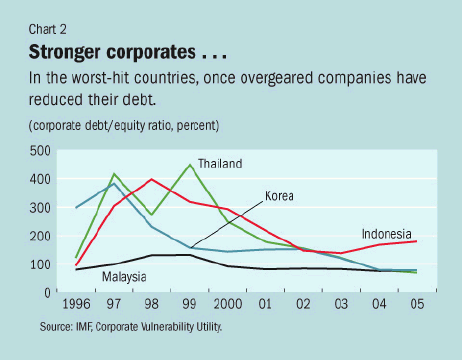
As for structural reforms, measures to deal with the immediate strains in the financial system have been complemented by steps to address the underlying weaknesses. Mechanisms to facilitate financial restructuring are now in place, regulatory and prudential frameworks have been upgraded, and corporate governance has been strengthened. More work lies ahead, but financial institutions and corporates in South East Asia have, on the whole, regained a solid footing (see Charts 2 and 3).
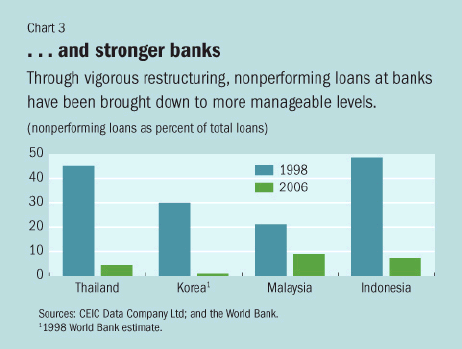
While the hardest-hit countries were busy cleaning up the legacies of the crisis, the rest of Asia was not standing still (see table). China and India have made further strides as regional powerhouses, the Philippines has weathered bouts of turbulence and gained considerable resilience, Vietnam has burst onto the global economic scene, and Japan has finally extricated itself from its "lost decade" and entrenched deflation.
The IMF has worked closely with economies in the region on their reform programs throughout the past decade. Increasingly, this has been done as part of the Fund's normal surveillance activities, including under new transparency and financial sector initiatives.
The next 10 years?
So what is ahead for Asia? Much will depend on whether it can tackle a number of issues over the medium term. While priorities differ across countries, a common theme stands out—coping with globalization and harnessing the tremendous upside it could deliver. For instance, the ever-greater participation of China and India in the global economy is opening up new horizons for the rest of the region, but the potential benefits do not come without risks. Nor does the increased fluidity of global capital movements. More broadly, as the pace of world integration quickens, vulnerabilities and social strains from rapid structural change and external shocks are bound to come to the fore, hand in hand with new opportunities. Governments—in Asia, as elsewhere—need to put in place shock absorbers to mitigate the impact of negative outcomes, as well as adopt policies that help capture the gains from deeper integration.
Although the challenges are many, here we focus on just two of the most important—the need to address worsening income inequality and learning to live with potentially unstable capital flows (for a more comprehensive take on Asia's policy agenda, see "Asia's Winds of Change," F&D, June 2006).
Income inequality. Over the past decade, inequality has risen steadily across the region. For example, China displays now a more skewed income distribution than the United States or Russia. Even Japan, once the poster child of a fairly equalitarian society, is today more unequal than the average industrial country. In fact, widely used measures of income dispersion, such as the Gini coefficient and indicators of the size of the middle class, all point in the same direction—a more unequal sharing of income (including along a rural-urban divide) and more polarization for Asian societies (see Chart 4).
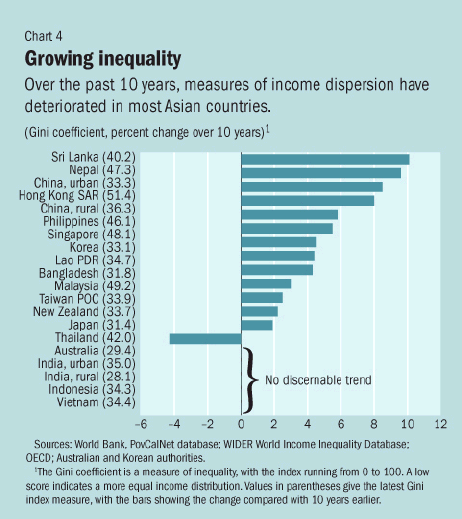
The causes of Asia's growing disparities are complex. Several factors may be at play, but skill-biased technical progress in the more advanced economies and the transition from agriculture to industry in developing ones appear to be the main forces shaping income distribution in the region. Globalization is of course providing the broader context for the changes in technology and patterns of production that are at the root of differential wage and sectoral developments. Besides ethical or social implications, worsening inequality is a concern for economic policymakers. If unattended, growing disparities could strain social cohesion and undermine the support for further engagement in the global economy, in spite of great potential benefits. More broadly, tears in the social fabric could lead to inferior economic outcomes—namely, lower long-term growth, macroeconomic instability, and dwindling room for maneuver when adverse shocks occur.
Asian policymakers are looking for ways to stem the trend. Specific measures depend on individual country circumstances, but in all cases need to be supported by sound macroeconomic management, which is necessary for sustainable growth. Growth holds out the greatest promise for lifting the poor out of poverty and providing better opportunities to the disadvantaged. Policy options to address inequality more directly include greater and more effective spending on education and infrastructure to build human capital and enhance the allocation of resources; labor market reforms that facilitate hiring and improve the employment conditions of nonregular workers; more equal access to financial markets to empower the poor and improve economic efficiency; and regulatory reforms to bolster the investment climate. Because the old tend to be poorer, steps to better absorb the fiscal impact of rapid population aging will also help redress income and geographical disparities in several countries.
Unstable capital flows. The other big challenge facing Asia relates to the ongoing integration of its capital market, both within the region and globally. The region's large current account surplus continues to be the main reason for its overall balance of payments surplus. But, whereas net inflows to Emerging Asia remain close to their long-run average relative to aggregate GDP, gross capital inflows and outflows are at record highs (see Chart 5). Capital is pouring in because of ample global liquidity and an expanded international investor base. It is being attracted by improved fundamentals, favorable interest rate differentials on domestic assets (especially against the yen), and broader and deeper regional financial integration. Savings have also been flowing out of the region as never before. Active official reserve management in some cases, more relaxed restrictions on residents' investment abroad in others, and—throughout the region—better integration of markets and production structures have provided powerful drivers for gross outflows.
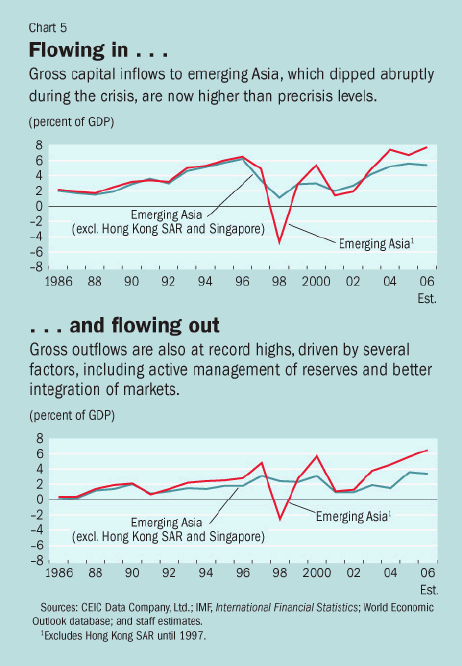
Gross flows have also become more volatile in recent years. The increased importance of portfolio and other investments (notably bank lending and derivative transactions) explains the trend and underscores the possibility of financial swings in either direction. Surges in capital movements (at times, in the context of yen carry trades—the practice of borrowing yen to invest in higher-yielding assets denominated in foreign currencies) have become a policy concern (see Chart 6). As the 1997-98 crisis made all too clear, rapid capital inflows carry the dangers of disruptive real appreciations, asset price bubbles, and imprudent domestic lending, on the one hand—and may lead to widespread economic and financial dislocations if they come to a sudden stop or turn into panic outflows, on the other.
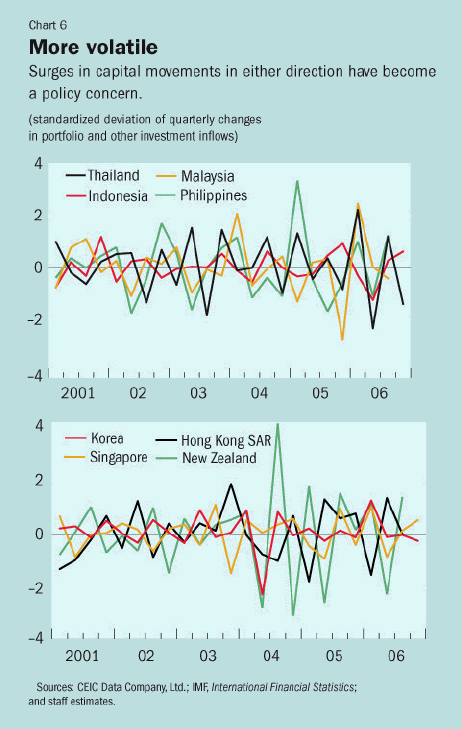
No surefire policy tool exists to deal with potentially unstable financial flows, but mutually reinforcing and consistent policies hold the best promise. Greater exchange rate flexibility in the context of sound macroeconomic policies—and, perhaps, intervention to smooth exchange rate movements without undue "leaning against the wind"—may be the least costly approach to absorb surges in capital inflows, after all.
A complementary strategy for Asia is to push forward with the development of domestic financial markets, including in the context of intraregional financial integration. Regional financial markets outside Hong Kong SAR, Singapore, and Tokyo are small, especially bond markets, and equity markets are less liquid than those in mature economies. Deeper and broader capital markets will provide a first bulwark against disruptions from unpredictable capital movements and perhaps add a measure of stability by retaining Asian savings within the region. Intraregional financial integration can be spurred by further steps to strengthen market infrastructure, corporate governance, and risk management at financial institutions, as well as coordinated efforts to harmonize financial regulations and tax treatments. Government-led initiatives in these areas are providing helpful support to a market-driven, bottom-up process in the background. Further liberalization of remaining restrictions on outflows can also support deeper integration and potentially offset swings in capital inflows.
Growing income inequality and potentially erratic capital flows are but two examples of the challenges that globalization presents to Asia. The to-do list for Asia's policymakers is longer. Steps are needed in many cases to encourage household consumption and private investment to reinforce the domestic underpinnings of growth and limit the region's reliance on external demand. Stronger domestic demand will go hand in hand with stronger currencies throughout the region, facilitating a global rebalancing of world growth and an orderly resolution of current account imbalances.
At the same time, protectionism must be resisted as external pressures to open up domestic markets build. By the same token, it will be important to avoid distortions to trade that the proliferation of preferential trade agreements in the region threatens to create. Additional product and labor market reforms may also be necessary to facilitate the development of new areas of comparative advantage as patterns of production and trade shift. Finally, many countries need to put in place welfare systems that cushion, but do not obstruct, structural change, while policy space must be found to deal with the environmental impact of rapid growth.
Ten years after a major financial crisis, Asia is looking at the future with renewed confidence and has good reason to do so. Ground has been regained where it had been lost, and Asia is well positioned to be an ever-greater force in the world economy. Encouragingly, policies are increasingly attuned to the quickening pace of globalization and the foundations for a sustained expansion are being laid. Although the list of policy issues still to address might seem daunting at first, reforms must be a continuous process in today's fast-paced and interconnected economy, and policies that address any one of these issues are likely to help on the other fronts as well. For its part, the IMF will continue to work closely with economies in the region to help them move forward with this reform process.
|
Asia includes some of the world's fastest-growing economies. | ||||
|
2005 |
2006 |
2007 |
2008 | |
| Latest projection | ||||
|
Industrial Asia |
2.0 |
2.3 |
2.4 |
2.1 |
|
Japan |
1.9 |
2.2 |
2.3 |
1.9 |
|
Australia |
3.1 |
2.4 |
2.6 |
3.3 |
|
New Zealand |
2.2 |
1.5 |
2.5 |
2.6 |
|
Emerging Asia |
8.6 |
9.0 |
8.5 |
8.1 |
|
Hong Kong SAR |
7.5 |
6.8 |
5.5 |
5.0 |
|
Korea |
4.2 |
5.0 |
4.4 |
4.4 |
|
Singapore |
6.6 |
7.9 |
5.5 |
5.7 |
|
Taiwan POC |
4.0 |
4.6 |
4.2 |
4.3 |
|
China |
10.4 |
10.7 |
10.0 |
9.5 |
|
India |
8.7 |
9.1 |
8.4 |
7.8 |
|
Indonesia |
5.7 |
5.5 |
6.0 |
6.3 |
|
Malaysia |
5.2 |
5.9 |
5.5 |
5.8 |
|
Philippines |
5.0 |
5.4 |
5.8 |
5.8 |
|
Thailand |
4.5 |
5.0 |
4.5 |
4.8 |
|
Vietnam |
8.4 |
8.2 |
8.0 |
7.8 |
|
NIEs1 |
4.7 |
5.3 |
4.6 |
4.6 |
|
ASEAN-52 |
5.5 |
5.7 |
5.8 |
6.0 |
|
Asia |
7.2 |
7.6 |
7.2 |
6.9 |
|
Sources: IMF, World Economic Outlook database; and staff estimates. | ||||
______________
David Burton is the Director and Alessandro Zanello an Assistant Director of the IMF's Asia and Pacific Department.
This article is from the June issue of the IMF's Finance & Development magazine.


